When carrying a firearm, you want to ensure that it is always within reach or accessible to you for a quick draw. Additionally, you want to make sure that the strap is firmly and securely fastened to you in order to prevent it from falling off unexpectedly. As a result of this, we can rely on our holsters to keep our firearms firmly in place. Holster retention is what we use to keep our pistol tight in the holster and is something we must consider if we intend to carry a handgun around.
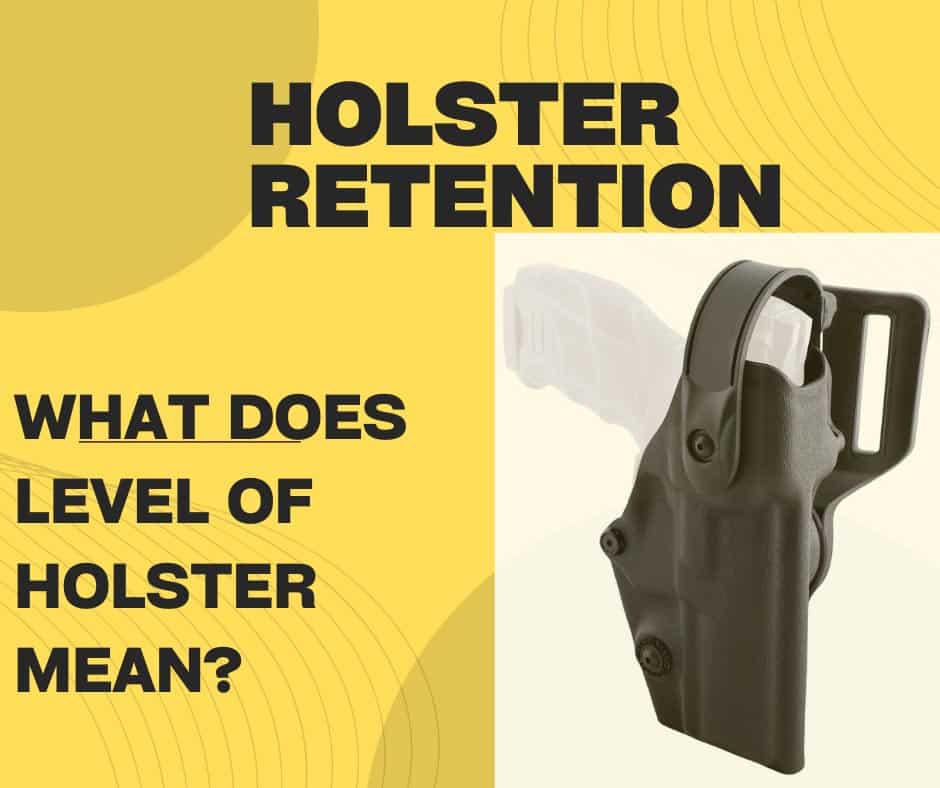
My first major experience with holster retention was years ago before I began shooting. As a young lad, I had noticed a pistol fall off a man trying to leave his seat after a meal at the restaurant. I got the scare of my life when the gun landed a few feet away from him. Anybody could have picked that up and become a threat to everyone I thought!
I didn’t know much about weapons at that time, but I understood that they were usually carried in holsters. My question then was – are holsters not meant to keep the gun in place? Why did this gun fall off the man? If I was to answer that long question now, I’d say he did not have the right holster retention level.
What does level of holster mean? In this article, we would unravel the difference in the holster retention level whether you just concealed carry for personal protection or law enforcement.
Holster Retention has different qualities, such as preventing a pistol from falling off and holding the firearm in a position for easy draw. How would it feel if your gun or holster falls off when you stumble on something? Would you want a stranger or an assailant to take your pistol from your holster easily without some resistance? Let’s dig a little further into what a handgun retention holster does.
Contents
- Explaining the Retention Holster
- Active Retention and Passive Retention Holsters
- The Holster Retention Level Guide: Level 1 Retention to Level 4 Retention
- Why Is Holster Retention Important
- Active Retention Device Types
- Holster Retention Mechanisms
- Choosing the Right Holster Retention Level
- I. Inadequate Holster Fit
- II. Poor Holster Positioning
- III. Neglecting Maintenance and Inspection
- Holster Retention Best Practices
Explaining the Retention Holster
When a layman hears the word “retention holster,” he or she may ask if certain holsters have no retention at all. The phrase “retention holster” refers to a holster that has somewhat greater retention than the ordinary holster.
Holster retention is an important concept to understand since it may assist a person to determine what to look for in open carry holsters or concealed carry holsters before buying one.
Active Retention and Passive Retention Holsters
There are two types of holster retention: active retention and passive retention.
Passive retention is the retention force inherent in a holster due to its design and manufacture. To put it another way, the materials, shape, and design of a holster allow it to grip a firearm to some extent. Passive retention is the natural retentive feature a holster possesses without using any open or lock methods.
In active retention, a user needs to engage an active retention device.
A gun holster could have any of the two, while some could have both. This is dependent on the holster’s design or retention level. A higher level “retention holster” usually has multiple retention devices, providing significantly greater security than many regular carry holsters.
The Holster Retention Level Guide: Level 1 Retention to Level 4 Retention
There are different holster retention levels. You might have noticed some Holster Accessories stores listing their holster from Level 1 retention holster, Level 2 holster, all the way up to Level 4 holster. This holster retention rating system is used because some of the holsters have more locks and unlocks than others.
Bill Rogers, a police instructor and former FBI agent who formed his own holster design company, particularly for law enforcement usage, invented the holster retention system in the 1970s. Each “level” represents an approximate amount of retention before the gun can be accessed. Under Rogers’ technique, a holster was subjected to a test in which someone attempted to pull the pistol from the duty holster as though they were attempting to take it away from a cop.
The “rating” system is intended to determine the number of retention devices. This is how it works:
Level I retention holster
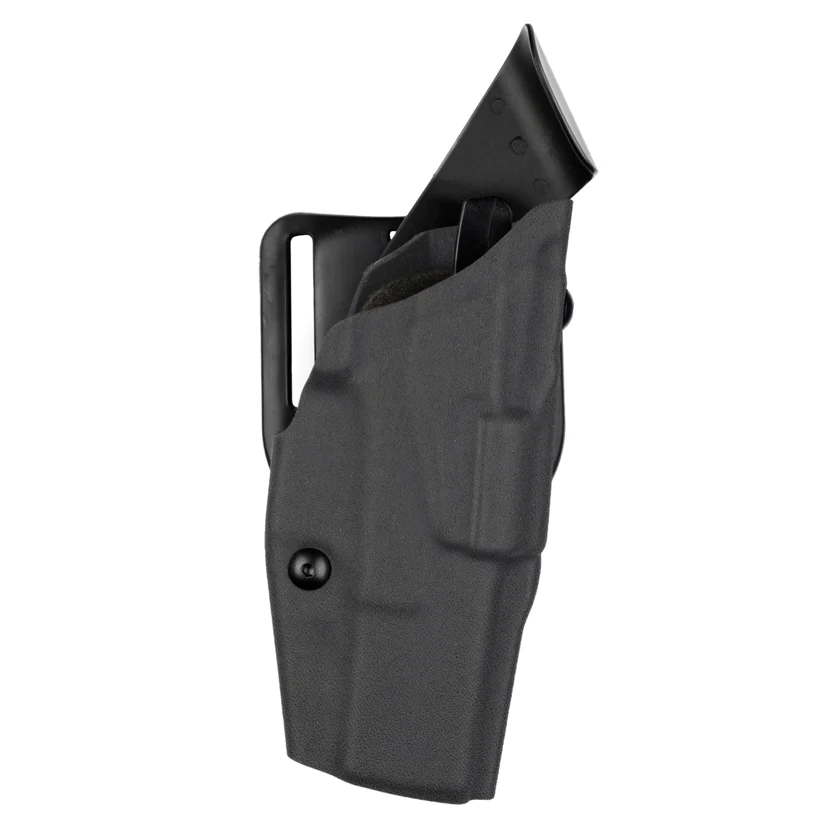
A Level I holster basically provides passive retention; the holster’s friction helps to keep the weapon in place. The majority of concealed carry holsters are level I. In a level I retention, the gun should not easily fall off out unless drawn correctly, or at least there should be some hold. A handgun holster that does not have passive retention is characterized as a level zero holster by some manufacturers.
Level II retention holster
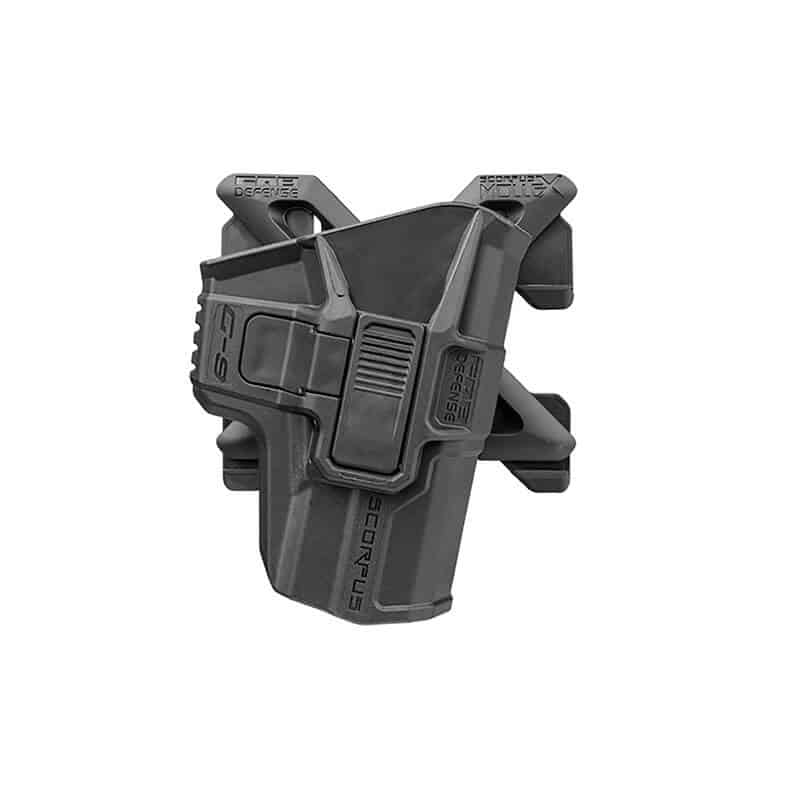
A Level II holster contains an active retention mechanism in addition to the holster’s passive retention, providing two sources of retention. The device in question is usually a hammer loop, trigger guard lock, or thumb break. These are widely used for open carry or by law enforcement agents.
Level III retention holster
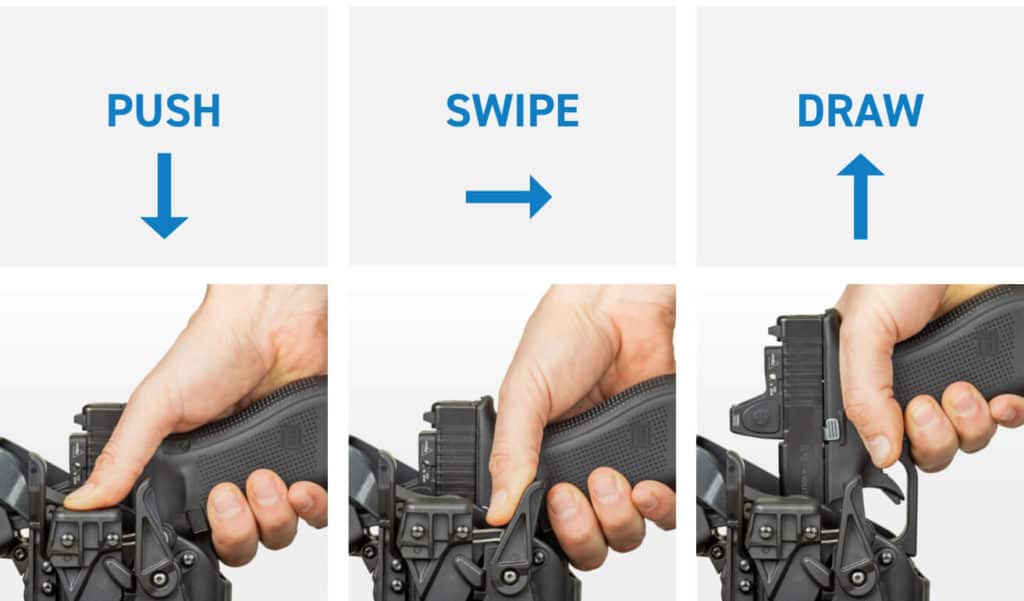
A Level III retention holster has an extra retention mechanism compared to the level II holster. The common design for this level of retention is a loop or thumb break, together with a trigger guard lock. These holsters are used by law enforcement, and some agencies around the country require uniform officers to carry a Level III retention holster.
Level IV retention holster
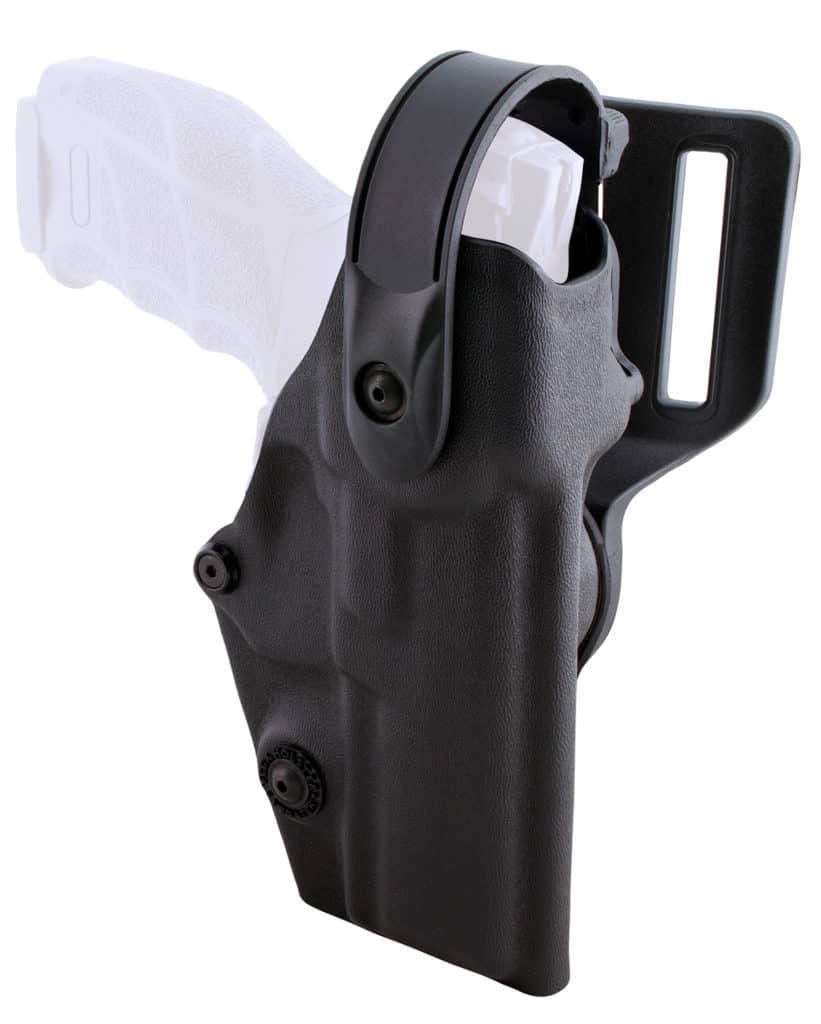
This level of retention has 3 active retention devices and passive retention, having a total of 4 retention mechanisms. These holsters are very rare to find compared to a Level III holster and represent the pinnacle of holster retention. A gun will not come out of a Level IV holster unless the wearer intends to use it.
Why Is Holster Retention Important
Possession of a gun holster or usage of the highest retention holster does not replace the need for learning how to use and keep your firearm safely. It is important to note that the holster could be taken off your belt and the pistol will be gone with it. Levels of retention should be considered an extra precaution rather than being the primary safety method for handgun retention. Let’s go into details on the two methods you can carry your gun.
Concealment Holsters-
Some people believe that only an Outside Waistband OWB holster needs a retention level. This is not totally true, although it is understandable for people to carry an Inside Waistband IWB holster without a level of retention or an active retention mechanism. However, an IWB holster user could be assaulted just like an OWB holster user.
If we want to focus on the fight over the gun, while wearing an IWB holster, the attacker could as well feel and recognize a handgun during the struggle. If the attacker decides to disarm you, your IWB without retention would not put up a fight and would make it easier for the attacker to take your gun.
Therefore, a level of retention that is beyond passive retention might be good for this scenario. You can concealed carry with a Kydex holster that has only friction as its retention, but this does not guarantee your safety in case of a struggle for gun possession. Some instructors at shooting range occasionally carry OWB in a pancake holster. You can always conceal your firearm in an OWB holster that is slim.
Even while using concealed carry IWB holster, if I don’t have some level of handgun retention, my ability to keep my handgun in my possession during combat would be compromised. Also, if an aggressor identified me as a gun carrier and noted the location of my firearm, then safety or element of surprise is compromised. Not only does the strong side hip provide additional opportunities for the bad man to obtain the weapon, but it is also more difficult to defend against than the appendix position. So, even if I carry concealed, I’d probably benefit from some retention in this kind of situation.
Open Carry-
If you’re planning to open carry, you should at least have a level I holster. I have seen so many people open carry with Uncle Mike’s holsters which is a very unpleasant thing to do. These one-size-fits-all holsters totally lack any level of retention and most times they do not even have passive retention, meaning the pistol would easily slip out when flipped upside down.
Although some retention might have their disadvantages. The placement of the retention strap on a holster can make it extremely difficult to easily draw out your gun.
There have been several occasions where gun carriers have been disarmed because they used an open carry holster. Some of these occurrences did not happen during a fight, but rather as a result of a criminal seeing an opportunity to obtain a pistol without having to pay or pass a background check.
Active Retention Device Types
Retention holsters have different types of retention devices. Generally, most handgun holsters come with a passive retention system, however, you need active retention mechanisms to have a higher retention level. Here are a few common types;
Thumb break: This type of retention device is usually made of leather (leather holster) but it can also be made of nylon and other materials, and it has a snap closure. The loop encloses the pistol’s back, preventing it from slipping out of the holster. The gun can only be accessible if you undo the snap on the holster.
Thumb loop: A retention device designed as a thumb loop is similar to a thumb break retention, the only difference is that it is a loop of material rather than a snap. The loop, which passes over the back of the slide or the hammer is sometimes known as a hammer loop. You cannot draw your weapon unless you undo or release it.
Trigger guard lock: This is a more recent retention device. The inside of the trigger guard is usually caught by a tiny hook or post. To draw the handgun, the lock must be deactivated. Finger or thumb releases are common. Some trigger guard lock systems are located outside of the holster, while others are on the inside; the user presses the button while holding the handgun and then draws.
Holster Retention Mechanisms
Thumb Break
The Thumb Break retention mechanism features a strap that secures the firearm in the holster, typically positioned just above the trigger guard. To draw the gun, you must release the strap with your thumb, hence the name. This mechanism provides an additional layer of security, reducing the risk of the gun falling out of the holster accidentally. It is commonly used by law enforcement officers and individuals who prioritize maximum retention.
Passive Retention
Passive Retention relies on friction and pressure to hold the firearm securely in the holster. It does not require any additional mechanisms or moving parts. The holster is designed to fit the specific firearm tightly, providing a secure hold while still allowing for a smooth draw. Passive Retention holsters are popular among concealed carriers who prioritize ease of access combined with a secure fit.
Active Retention
Active Retention mechanisms involve additional features that go beyond friction to keep the firearm in place. Examples of active retention mechanisms include adjustable tension screws, levers, or buttons that must be pressed or released to draw the gun. These holsters offer an extra level of security and are commonly used in high-risk situations or professional settings where the potential for weapon retention is critical.
Choosing the Right Holster Retention Level
When selecting a holster, considering the appropriate retention level is crucial to meet your specific needs. Factors such as concealed carry, open carry, and training and experience play a significant role in determining the ideal retention level for your holster.
Considerations for Concealed Carry
Concealed carry holsters typically require a balance between retention and ease of access. You want a holster that securely holds your firearm close to your body to prevent printing or accidental exposure, while still allowing for a quick and smooth draw when needed. Passive Retention holsters with adjustable tension screws are often favored for concealed carry, as they offer customization to achieve the desired level of retention.
Considerations for Open Carry
Open carry holsters can have a higher retention level since concealment is not a concern. Active Retention holsters are commonly used for open carry, as they provide an additional layer of security against attempted weapon grabs or accidental dislodging. However, it is essential to balance retention with accessibility, ensuring that you can draw your firearm swiftly when necessary.
Training and Experience
Your level of training and experience with firearms should also influence your choice of holster retention level. Beginners may prefer holsters with higher retention levels to instill confidence in firearm retention. As your proficiency and comfort increase, you can opt for holsters with lower retention levels while still maintaining a secure hold. Training and practice are essential to ensure a smooth and confident draw, regardless of the chosen retention level.
Common Mistakes to Avoid with Holster Retention
Holster retention is a crucial aspect of responsible firearm ownership. It ensures that your firearm remains securely in its holster until intentionally drawn, preventing accidental discharges and ensuring your safety and the safety of those around you. However, many gun owners make common mistakes that compromise holster retention, potentially leading to hazardous situations. In this article, we will explore the most common mistakes to avoid with holster retention and provide you with best practices for maintaining a secure and reliable holster system.
I. Inadequate Holster Fit
One of the primary mistakes gun owners make is choosing a holster that does not provide a proper fit for their firearm. An ill-fitting holster can lead to a variety of issues, including poor retention. When the holster doesn’t snugly hold the firearm, it increases the risk of accidental dislodgment, especially during physical activities or sudden movements. To avoid this mistake, ensure that you select a holster specifically designed for your firearm model. A holster with adjustable retention mechanisms can further enhance the fit and retention.
II. Poor Holster Positioning
The positioning of your holster plays a significant role in retention. Placing your holster in an inappropriate position can compromise your ability to draw the firearm quickly while maintaining retention. Some gun owners make the mistake of positioning the holster too low on the waistband or too close to the back, making it difficult to access the firearm efficiently. On the other hand, positioning the holster too high or at an awkward angle can hinder a smooth draw and increase the chances of accidental discharge. Finding the optimal position for your holster that ensures both comfort and quick access is crucial.
III. Neglecting Maintenance and Inspection
Neglecting regular maintenance and inspection of your holster can also lead to retention issues. Over time, dirt, dust, lint, and debris can accumulate in the holster, affecting its retention capabilities. Additionally, wear and tear can weaken the holster’s materials, straps, or retention mechanisms. By neglecting maintenance and inspection, you risk compromising the security of your firearm. It is essential to clean your holster regularly, removing any debris and ensuring all moving parts function correctly. Inspect the holster for signs of wear and tear, such as loose stitching or damaged retention mechanisms, and promptly address any issues to maintain optimal holster retention.
Holster Retention Best Practices
While avoiding common mistakes is crucial, implementing best practices for holster retention can significantly enhance your firearm’s security. Here are some recommended practices to ensure reliable holster retention:
A. Proper Firearm Presentation
When drawing your firearm, practice the proper presentation technique. Maintain a firm grip on the firearm while applying appropriate force to overcome the holster’s retention mechanisms. Ensure your trigger finger is indexed along the slide or frame, outside the trigger guard, to prevent any accidental discharges. Practice this technique regularly to build muscle memory and reinforce safe and effective firearm presentation.
B. Consistent Training and Practice
Holster retention skills require consistent training and practice. Familiarize yourself with your holster’s specific retention features and practice drawing and reholstering your firearm under controlled conditions. Regular training sessions will help develop your proficiency and confidence in handling your firearm, ensuring that you can swiftly and safely draw and reholster your weapon when needed.
C. Regular Equipment Check
Perform routine inspections of your holster and its components to identify any signs of wear, damage, or malfunction. Check the stitching, retention mechanisms, straps, and belt loops to ensure they are secure and in good condition. If you notice any issues, repair or replace the holster immediately. Regularly check the fit of your firearm in the holster to ensure it remains snug and secure.
- What is the definition of “holster retention”?
Holster retention refers to the ability of a holster to securely hold a firearm in place, ensuring that it remains in position until intentionally drawn.
- How does the level of holster impact firearm security?
The level of holster plays a crucial role in determining the level of security provided to the firearm. A higher retention level generally indicates increased security, reducing the chances of accidental or unauthorized access.
- What are the different levels of holster retention?
Holster retention can be categorized into multiple levels, each offering a varying degree of security. These levels are typically classified as level 1, level 2, and level 3, with level 3 providing the highest level of retention.
- What is a thumb break, and how does it contribute to holster retention?
A thumb break is a mechanism commonly found in holsters that adds an additional layer of retention. It involves a strap or lever that can be released with the thumb, allowing for quick and secure access to the firearm while enhancing the overall retention of the holster.
- What is the difference between passive and active retention holsters?
Passive retention holsters rely on the inherent design and tension of the holster to secure the firearm in place. Active retention holsters, on the other hand, incorporate additional mechanisms such as locking systems or straps for enhanced security.
- How do I choose the right holster retention level for concealed carry?
Selecting the appropriate holster retention level for concealed carry depends on various factors, including personal preference, comfort, and the specific requirements of the intended application. It is essential to consider the balance between security and ease of access when making this decision.

Brian Belko is a freelance writer and blogger. His primary areas of focus include the outdoors and shooting sports. In addition to his freelance work, Brian also writes for Wide Open Spaces and is on the Pro Staff at Military Hunting and Fishing. When he isn’t busy writing, Brian enjoys fishing farm ponds for bass and hitting the spring woods during turkey season.
